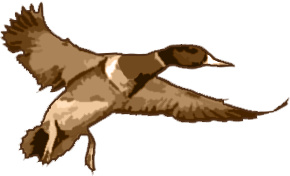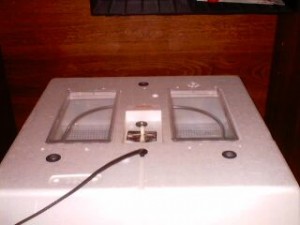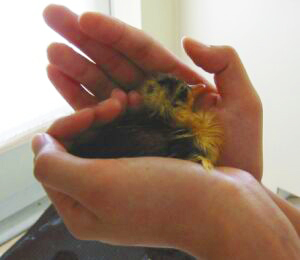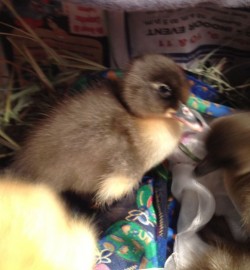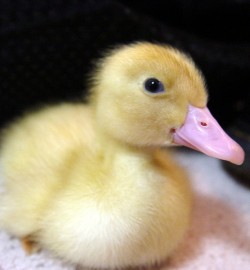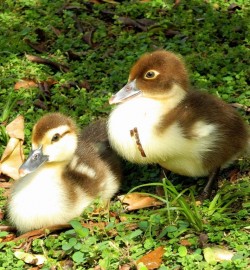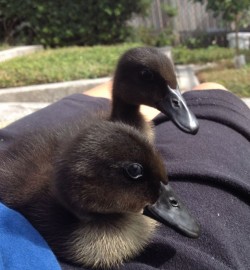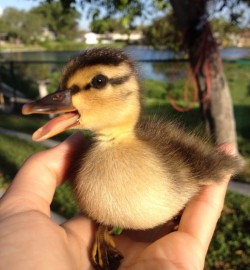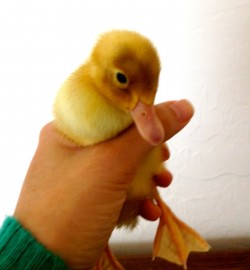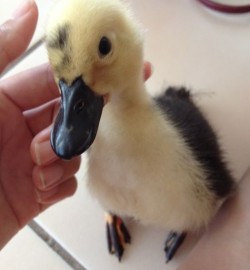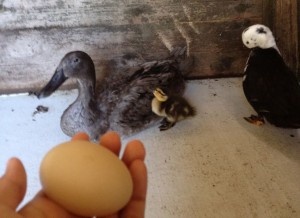
The easiest way to hatch eggs is with an incubator if you don’t have yourself a broody chicken or goose. If you’re just getting started, a still air incubator is relatively cheap and simple to use. Go on down to your local feed store, they usually sell for about $50, or consider making your own as I did, in The Home Made Incubator .
It takes approximately 28 days for a duck egg to hatch (this often varies from species to species, ie Muscovies may take one more day). From about a week to a few days before hatching, you can feel the baby bird moving around inside the egg. Imprinting starts while the baby is still inside the egg. When the baby pips the egg (2 days before hatching) it can hear and respond to sounds. If you want your bird to learn its name, now is the time. When ducks are inside their eggs, they concentrate on sound more than they would normally. It will imprint immediately to your voice so it will know you when it hatches.
There is also a trick called “Candling”, where you hold a flash light under the egg and you can see the embryo that lies within. Click here to see Duck Egg Candling – what a bad egg looks like, what a good egg looks like The blastoderm, or germinal spot of the embryo, always floats on top and can be seen within 48 hours of incubation. It’s easier to witness if the eggs are white; bad eggs often look a lot like developing embryos in dark colored eggs. At this point, the only way you can tell an egg is bad is to lift the eggs to your nose and give them a smell! Eggs should be turned 2-3 times per day until external pipping occurs (around the 26th day of the total 28 day incubation period).
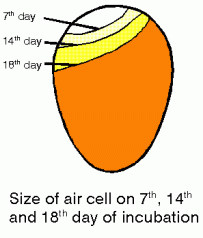
This diagram demonstrates how air space grows over time. Over the course of incubation, you should be able to see the air sacs inside your duck eggs expand – this is a result of evaporation. Duck eggs lose weight over the process of incubation – this is necessary for hatching. Hopefully your eggs will have lost just the right amount of water. The duck will pierce the egg sac during internal pipping (around day 25 or day 26) and you will hear their voice for the first time. Approximately ONE day after internal pipping, your duck will external pip, ie create a small hole through the shell. If your duck has not externally pipped within 24 hours of an internal pip, you should poke gently through the shell and the membrane with a needle and provide him with a hole big enough to breathe through. I almost lost one of my ducklings because the membrane of his egg was abnormally thick and rubbery and he could not break himself out even though the entire shell was cracked through.
Before internal or external pip, the chick is supplied air via its porous egg shell. This permits the transfer of gaseous waste and oxygen. The egg-white of an egg itself is full of protein that is about 88% water and 10% amino acids. It is theorized that the egg white helps support the egg yolk and keeps the developing embryo from drying out. Because eggs are porous, it is important that they are kept in a clean environment so that they are not infected. When eggs are first laid, they are covered in a protective enzyme film (provided by the mother bird) which guards it from bacteria. For this reason, many people do not wash eggs gathered from birds that are to be incubated. Be sure to properly disinfect your hands each time before you touch your eggs! Bacteria and viruses can easily be transferred through the porous shell.
It is important to note that still air incubator temperature needs to be HIGHER than a forced air incubator temperature. Forced air incubators can be set to 99.5 F, whereas still airs should be set to between 99-101F. This is because still air incubators create a temperature layering effect. Without fans to circulate the air, hot air , as you know, will rise to the top and stay there. For this reason, you should place your thermometer at egg level , or nearly on top of the eggs, so you are getting an accurate reading.
a 10 minute old duckling
